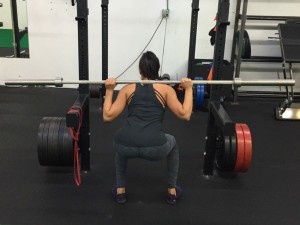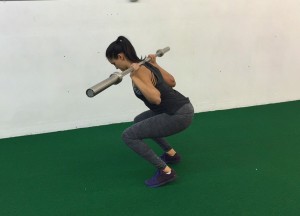Squats are an exercise I used to hate. Although I still don’t feel all warm and fuzzy inside when I think about doing them, I have since moved onto a love/hate relationship with the exercise – which I hope eventually turns into a hate-free one. Though I am sceptical that’s going to happen… I digress.
There is nothing more satisfying as a strength coach than watching someone perform a good quality squat with ease. Especially someone who has come to you with a squat that looks something like the picture above.
If your squat looks something like that, there is likely something that is restricting you from reaching your full squat potential. The question is, what is it?
There are a couple of common factors that could be contributing to your less than stellar squat. The most notable ones being…
- Restricted mobility in your ankles, hips and upper back, which will all affect your ability to squat well
- Inadequate stability or motor control. You can have all the flexibility in the world, but poor stability or motor control will cause your form to fall apart
**If either of these sound like you, check out THIS awesome post before reading any further.
- Previous injury is a common reason why you might be struggling to perform a good squat. But it may shock you to know that learning to squat properly is actually part of many post-knee injury rehab protocols
- Your hip structure. Everyone has a different hip make up. For example: for some people the bony structure of their pelvis will limit how low they can drop into a squat
There are a number of reasons why your body might try to compensate when you squat, so except the fact that things are going to go wrong, now. It’s not a matter of if. It’s a matter of when. The sooner you accept it, the sooner you can do something about it.
That said, there are ways to help fix the inevitable so that you can squat effectively. Below are some common squatting pitfalls that will make your trainers’ eyes bleed, and quick fixes to help you clean them up right now.
Have a read through them and find the mistake that best describes you!
4 Common Squat Mistakes
1. Caving Knees
Are your knees caving in when you squat? Instead of continuing to load a dysfunctional movement and creating compensation that can lead to injury, we often use a technique called Reactive Neuromuscular Training (or RNT) at BIM. The goal of RNT is “feed the mistake,” forcing your body to self-correct faulty movement patterns. When completing an exercise with RNT, ensure that you decrease the amount of load you are lifting. Your primary goal is to restore the pattern so that you can perform a squat properly.
The next two exercises are examples of how to use RNT to help restore proper squatting patterns.
PRO TIP: Try using a mini band just below your knees. Fight the pull of the band on the way down as you drive your knees out so that they’re in line with your toes. If your squat looks like the example above, you’ll be surprised by how much more stable you will feel with some band RNT.
2. Shifty Hips
If you find that you are constantly shifting your weight to the side, try a squat with a lateral RNT, with the band pulling you in the direction of the shift. In other words, “feed the mistake.” This will give your body some feedback to help it self-correct.
3. Poor Back Positioning
Have trouble sitting back into your squat? This is one of the most common squatting pitfalls, and there are a couple of reasons why it might be happening.
First things first, what kind of footwear are you squatting in? Many running shoes have a significant heel drop, making it difficult to sit your weight back and load your heels. An elevated heel will also decrease glute activation, and as a result, your squat will become more of a quadricep-dominant exercise. Over time, this can put stress on your knees and potentially lead to injury; which of course, you don’t want.
What’s the solution?
Here are three…
- Lift in a zero-drop shoe: If you have adequate ankle range of motion, try lifting in a zero-drop shoe, where your heel and forefoot are an equal distance from the ground.
- Front load your squat: Front loading your squats will give you some counter balance and allow you to comfortably sit back without feeling like you’re going to eat shit.
- Add a target: Adding in a target, such as a medicine ball or a bench to reach back to will provide you with some feedback, again with less fear of bailing.
All three of these modifications can work wonders and ensure that your heels are loaded correctly, that your weight is shifted back, and ultimately better engage your glutes. Three things that you want when squatting.
4. Incorrect Squat Posture

Do you struggle to keep an upright posture and a neutral spine when you squat? Simple fix, squeeze the bell hard during your goblet squats. Doing so will help engage your anterior core and lats, which adds a lot more stability. Your sloppy squats will likely clean themselves right up with this method.

No matter what’s hindering your squat, there is a correction that will help you fix it. So if you’re making one of the above mentioned mistakes, try the quick fix that best matches it so that you can start getting into the right squat form. Doing so will help you get more out of your squats, and eventually teach you to love the exercise.
If you have any questions about squats, please don’t hesitate to reach out to me at jen@balancemotion.com. You can also schedule a free fitness assessment with us HERE.
Happy lifting!
Jen








